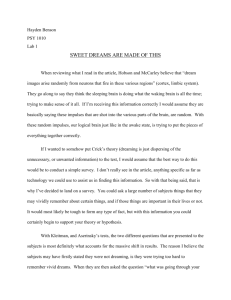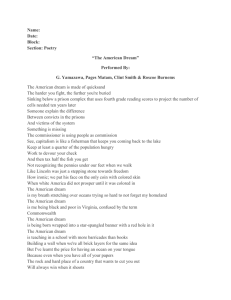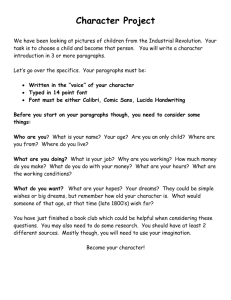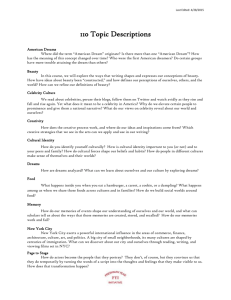Dream Journal and Theory Project
advertisement
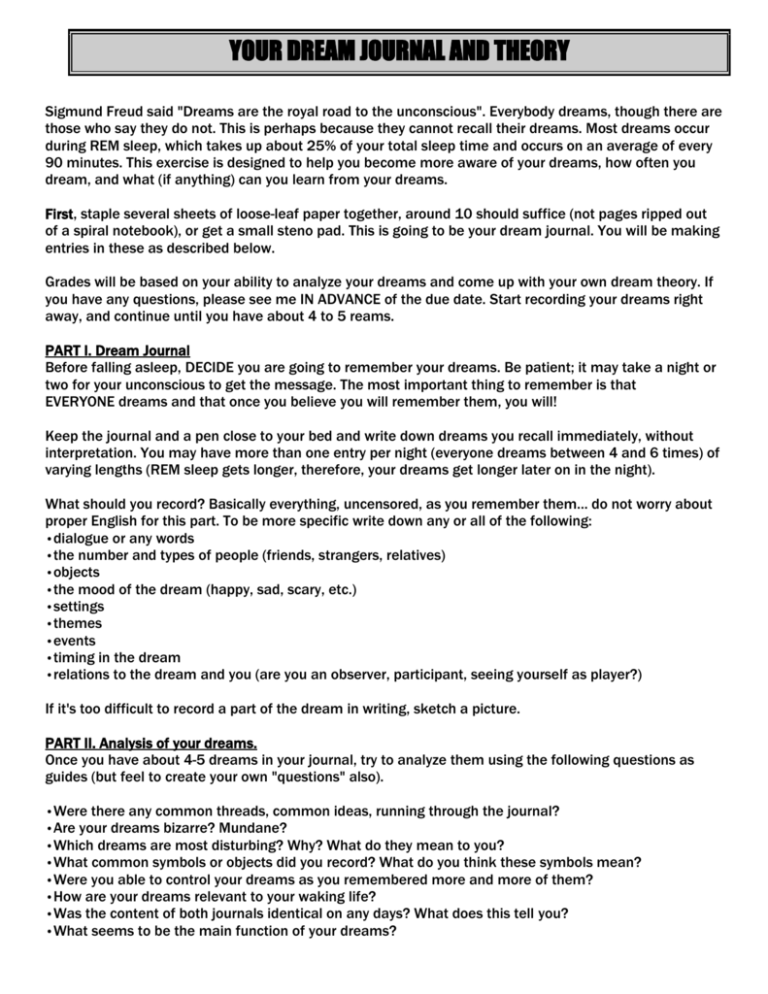
YOUR DREAM JOURNAL AND THEORY Sigmund Freud said "Dreams are the royal road to the unconscious". Everybody dreams, though there are those who say they do not. This is perhaps because they cannot recall their dreams. Most dreams occur during REM sleep, which takes up about 25% of your total sleep time and occurs on an average of every 90 minutes. This exercise is designed to help you become more aware of your dreams, how often you dream, and what (if anything) can you learn from your dreams. First, staple several sheets of loose-leaf paper together, around 10 should suffice (not pages ripped out of a spiral notebook), or get a small steno pad. This is going to be your dream journal. You will be making entries in these as described below. Grades will be based on your ability to analyze your dreams and come up with your own dream theory. If you have any questions, please see me IN ADVANCE of the due date. Start recording your dreams right away, and continue until you have about 4 to 5 reams. PART I. Dream Journal Before falling asleep, DECIDE you are going to remember your dreams. Be patient; it may take a night or two for your unconscious to get the message. The most important thing to remember is that EVERYONE dreams and that once you believe you will remember them, you will! Keep the journal and a pen close to your bed and write down dreams you recall immediately, without interpretation. You may have more than one entry per night (everyone dreams between 4 and 6 times) of varying lengths (REM sleep gets longer, therefore, your dreams get longer later on in the night). What should you record? Basically everything, uncensored, as you remember them... do not worry about proper English for this part. To be more specific write down any or all of the following: •dialogue or any words •the number and types of people (friends, strangers, relatives) •objects •the mood of the dream (happy, sad, scary, etc.) •settings •themes •events •timing in the dream •relations to the dream and you (are you an observer, participant, seeing yourself as player?) If it's too difficult to record a part of the dream in writing, sketch a picture. PART II. Analysis of your dreams. Once you have about 4-5 dreams in your journal, try to analyze them using the following questions as guides (but feel to create your own "questions" also). •Were there any common threads, common ideas, running through the journal? •Are your dreams bizarre? Mundane? •Which dreams are most disturbing? Why? What do they mean to you? •What common symbols or objects did you record? What do you think these symbols mean? •Were you able to control your dreams as you remembered more and more of them? •How are your dreams relevant to your waking life? •Was the content of both journals identical on any days? What does this tell you? •What seems to be the main function of your dreams? •What was the manifest content, what was the latent content? In other words, what did you learn about yourself by recording your dreams in a journal? Write a thesis statement, and support it with references directly from your dreams. Summarize the dreams you discuss in your report. Consider comparing settings, plots, characters, emotions, and colors. You should think of your dreams as a collection of stories and Part II as an analysis of these stories and what they say about you when looked at together. The report should be in essay/paragraph form. Do not just write sentences answering each question, rather have a thesis in mind that connects all the individual ideas. The written report is to be typed, around 2-3 pages, and double-spaced. PART III: Your Dream Theory This is the major element of this project. Once you have completed the readings and Parts I and II, you will develop your own Dream Theory using your dreams and our readings on dream theories. General Guidelines These questions are to help you begin organizing your thoughts about your theory. You may change the order in which you address them and add your own points as necessary. REMEMBER- this paper is to be in paragraph form!!!! Do not just answer the questions and turn in a "choppy" and illogical report. Again this paper should have a thesis that clearly articulates your theory on dreams. It should use your dreams and the research from the readings as support. Your essay should accomplish the following: 1. Identity your dream theory a. Is it your own? If it is, you must show what it is better than the other theories. b. Is it one that you have read? c. Is it a combination of those you have read? 2. Explain your theory a. What is the purpose of dreaming in your theory? b. What do things mean? The depth of your theory will determine the length of the paper. Please make sure you address all points. Most papers will probably be between 3-4 pages. DREAM THEORY PROJECT SCORE GUIDE PART I: DREAM JOURNAL Thoroughness of journal 4-5 dreams _______/5 _______/10 PART II: WRITTEN REPORT ON YOUR DREAM JOURNAL Thesis Depth of the analysis Adequate use of dreams to support analysis Mechanics and length _______/2 _______/10 _______/5 _______/3 PART III: DREAM THEORY Fully developed and well reasoned dream theory Dream theory is clearly articulated in thesis Adequate use of evidence to support your dream theory Mastery of terminology and opposing theoretical approaches Mechanics and length _______/12 _______/5 _______/7 _______/13 _______/3 TOTAL _______/75
